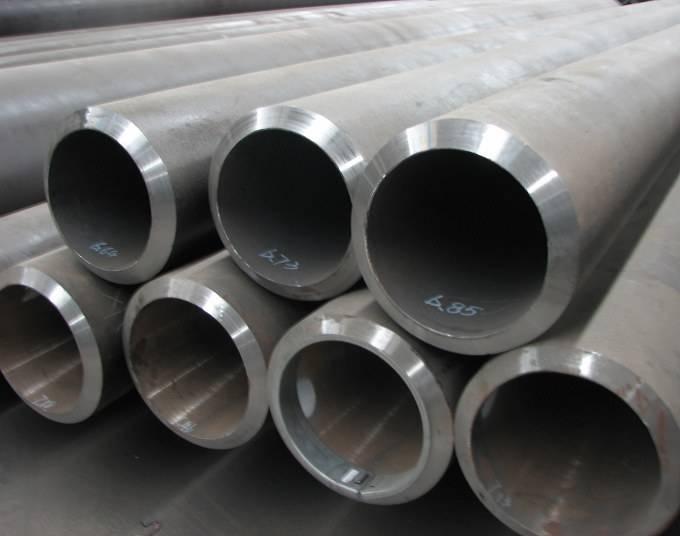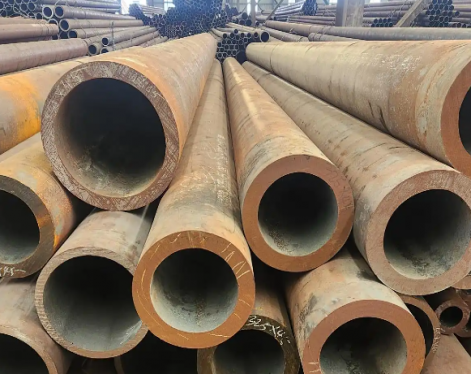The welding process of seamless steel pipe mainly includes two steps: trimming, butt welding and submerged arc welding.1.Trimming, counterpart:
Trimming is concentrated before the pipeline leaves the factory. In order to ensure the welding quality, a comprehensive inspection and correction are carried out before welding, so that the end face, bevel angle, blunt edge and roundness of the pipe meet the requirements of the size of the butt joint.When individual steel pipes need to be beveled on site, gas welding is used to cut, remove the slag, and then use a grinding wheel to smooth it.The corresponding operation procedure is: check the size of the interface joint → clear the cavity → determine and adjust the staggered position of the longitudinal weld of the steel pipe → find the straight line for the first time → adjust the gap size of the counterpart → level the pipe line → find the straight line of the pipeline → spot welding.

2. Welding
The joint welding adopts arc welding, one time for priming, two times for survival, each welding seam is welded once, and the arc ignition and extinguishing points of each layer of welding must be staggered.
1) Before welding, the pipe joints should be trimmed, slag cleaned, the bevel angle, blunt edge, and gap of the pipe end face should comply with the specifications: it is not allowed to clamp the welding bar in the opposite gap or use the heating method to narrow the gap for welding.
2) The inner wall should be flush when matching, and a straight ruler with a length of 300mm should be used to attach to the inner wall of the interface in sequence. The allowable deviation of the wrong mouth should be 0.2 times the wall thickness, and should not be greater than 2mm.
3) The position of the opposite longitudinal and circumferential welds shall meet the following requirements:
a. The longitudinal weld should be at about 45° of the semicircle on the vertical line of the pipe center
b. For steel pipes with reinforcement, the butt weld of the reinforcement ring should be staggered from the longitudinal weld of the pipe section, and the distance should not be less than 100mm; the distance between the reinforcement ring and the circumferential weld of the pipe section should not be less than 50mm
c. There shall be no cross-shaped welds in any position of the pipeline.
4) During tack welding, all electrode numbers (or grades) of tack welds should be the same as those of formal welding, but the diameter of the electrodes can be selected to be thinner. The welding current of the tack weld should be larger than that of the formal welding, usually 10%-15% larger to ensure the penetration.
5) Welding of pipelines: The quality of the welds must comply with the relevant provisions of 4.2 in GB50268-97. The welds should be smooth, with the same width and width, and the roots should be penetrated without obvious concave and convex defects and undercuts.The reinforcing surface of the weld should be about 2 mm higher than the pipe surface, and the edge of the welding groove should be 2-3 mm.
6) When welding the pipeline and the flange, the pipeline should be inserted into two thirds of the flange, the flange and the pipeline should be perpendicular, and the axes of the two should be coincident.
a. The slope of the horizontal pipeline shall not be less than 0.3%.
b. The welding environment should be checked before welding, and the drying and cleaning of welding installation equipment and welding materials must comply with the specifications and welding operation regulations.
c. When welding double-sided weldments, the back of the root of the weld should be cleaned and inspected. After cleaning the defects, the back weld can be welded. It is stipulated that the welding seam of root cleaning shall be subjected to visual inspection after root cleaning before welding.
d. Pipes with a pipe wall greater than 4mm must be grooved before welding, and the groove surface must not have defects such as interlayers, cracks, processing damage, burrs and flame cutting slag. After welding, the coating should be knocked clean, the welding joint should be in a uniform scale shape, and there should be no pores, slag inclusions, cracks, welding lumps, etc., and the length of the bite meat should be within the specification requirements.
Trimming is concentrated before the pipeline leaves the factory. In order to ensure the welding quality, a comprehensive inspection and correction are carried out before welding, so that the end face, bevel angle, blunt edge and roundness of the pipe meet the requirements of the size of the butt joint.When individual steel pipes need to be beveled on site, gas welding is used to cut, remove the slag, and then use a grinding wheel to smooth it.The corresponding operation procedure is: check the size of the interface joint → clear the cavity → determine and adjust the staggered position of the longitudinal weld of the steel pipe → find the straight line for the first time → adjust the gap size of the counterpart → level the pipe line → find the straight line of the pipeline → spot welding.

2. Welding
The joint welding adopts arc welding, one time for priming, two times for survival, each welding seam is welded once, and the arc ignition and extinguishing points of each layer of welding must be staggered.
1) Before welding, the pipe joints should be trimmed, slag cleaned, the bevel angle, blunt edge, and gap of the pipe end face should comply with the specifications: it is not allowed to clamp the welding bar in the opposite gap or use the heating method to narrow the gap for welding.
2) The inner wall should be flush when matching, and a straight ruler with a length of 300mm should be used to attach to the inner wall of the interface in sequence. The allowable deviation of the wrong mouth should be 0.2 times the wall thickness, and should not be greater than 2mm.
3) The position of the opposite longitudinal and circumferential welds shall meet the following requirements:
a. The longitudinal weld should be at about 45° of the semicircle on the vertical line of the pipe center
b. For steel pipes with reinforcement, the butt weld of the reinforcement ring should be staggered from the longitudinal weld of the pipe section, and the distance should not be less than 100mm; the distance between the reinforcement ring and the circumferential weld of the pipe section should not be less than 50mm
c. There shall be no cross-shaped welds in any position of the pipeline.
4) During tack welding, all electrode numbers (or grades) of tack welds should be the same as those of formal welding, but the diameter of the electrodes can be selected to be thinner. The welding current of the tack weld should be larger than that of the formal welding, usually 10%-15% larger to ensure the penetration.
5) Welding of pipelines: The quality of the welds must comply with the relevant provisions of 4.2 in GB50268-97. The welds should be smooth, with the same width and width, and the roots should be penetrated without obvious concave and convex defects and undercuts.The reinforcing surface of the weld should be about 2 mm higher than the pipe surface, and the edge of the welding groove should be 2-3 mm.
6) When welding the pipeline and the flange, the pipeline should be inserted into two thirds of the flange, the flange and the pipeline should be perpendicular, and the axes of the two should be coincident.
a. The slope of the horizontal pipeline shall not be less than 0.3%.
b. The welding environment should be checked before welding, and the drying and cleaning of welding installation equipment and welding materials must comply with the specifications and welding operation regulations.
c. When welding double-sided weldments, the back of the root of the weld should be cleaned and inspected. After cleaning the defects, the back weld can be welded. It is stipulated that the welding seam of root cleaning shall be subjected to visual inspection after root cleaning before welding.
d. Pipes with a pipe wall greater than 4mm must be grooved before welding, and the groove surface must not have defects such as interlayers, cracks, processing damage, burrs and flame cutting slag. After welding, the coating should be knocked clean, the welding joint should be in a uniform scale shape, and there should be no pores, slag inclusions, cracks, welding lumps, etc., and the length of the bite meat should be within the specification requirements.









